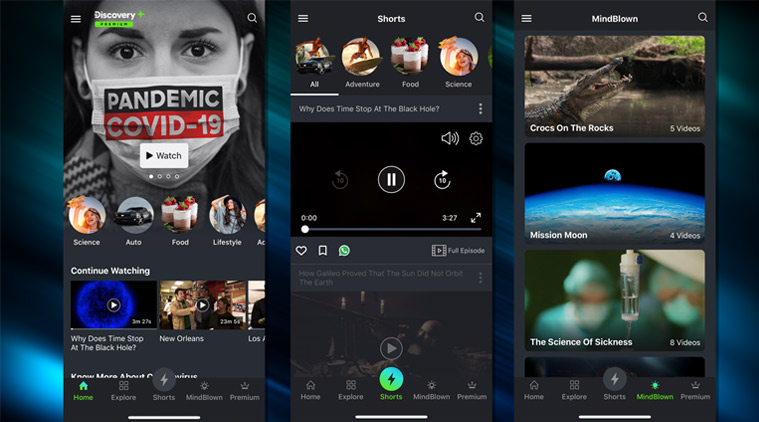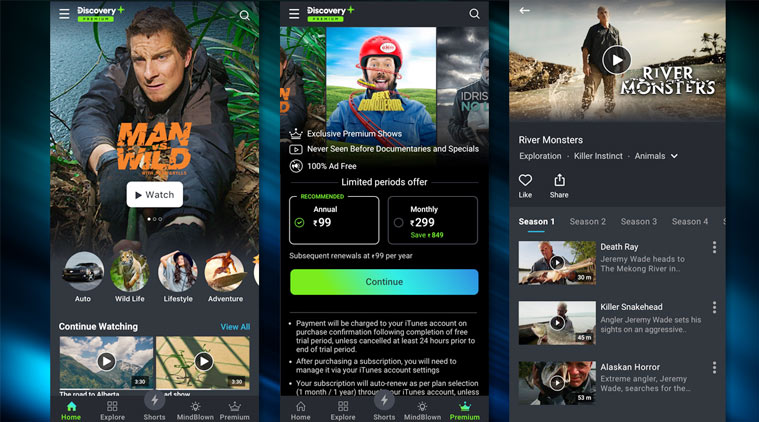 Creating the Discovery+ app: We spoke to the team behind this on how one creates a streaming app for a market like India. (Image created by Gargi Singh)
Creating the Discovery+ app: We spoke to the team behind this on how one creates a streaming app for a market like India. (Image created by Gargi Singh)
India has of late become a crowded market for streaming services. So how does one go about creating and launching an app, that too for niche content? Ask Discovery, which just launched its Discovery+ app and website, bringing together content from the Discovery Channel, the Travel Living Channel (TLC), Animal Planet, Discovery Science and Discovery Turbo.
For the team at Discovery+, it was clear there were many challenges that they had to keep in mind. For instance, unlike other streaming apps and services in India, Discovery+ has no movies, no scripted TV shows, and the focus is on content around adventure, wildlife, travel, lifestyle, which is what the brand is known for.
This would also explain why they chose to team up with Robosoft Technologies, which has in the past created digital businesses for companies and worked on apps for Paytm, Myntra, Flipkart, Viacom, VOOT and NDTV among others. A full service digital experiences company is how Robosoft Technologies describes itself.
“We were aware that this market is extremely competitive because you have got short form players like TikTok, global players like Netflix, etc. There’s also the barrier of time. Discovery is known for making 20 minute, 40 minute, 60 minute specials. But today people might not have that time,” Issac John, Discovery’s Business Head – Digital (South Asia) explained to indianexpress.com in a phone call.
Discovery’s team is targeting users who they believe are lifelong learners, which is not a space other streaming services typically focus on. “We are competing for the consumer’s mind space and time,” John added.
 Issac John, Discovery’s Business Head – Digital (South Asia) in this photo. (Image source: Discovery)
Issac John, Discovery’s Business Head – Digital (South Asia) in this photo. (Image source: Discovery)
They also had to make sure that search was easy on its app given they have a huge library of premium content. “We had to make sure people should be able to come to the app and get curated collections of their own. So if a customer came from Tamil Nadu, they should see clearly that content is available in their language,” John explained further.
Designing an app for Discovery
According to Ravi Teja Bommireddipalli, CEO at Robosoft Technologies, for a company like theirs the first step in designing an OTT app or any other streaming app is to do what they call an ‘empathy session’. This is done with potential end users to gauge their needs.
“We meet end users, listen to them, observe them and get a lot of insights, which then helps us come up with features which can differentiate and provide insights into how this particular OTT app can be different from what is available,” he explained adding that these empathy sessions help them come up with a product roadmap.
Robotsoft had a 35-member technology team working on the user experience and user interface and they worked closely with Isaac’s team in Discovery. With Discovery+, Robosoft had to put in subtle differences. For instance, unlike other streaming apps which show episode one, two, three for a show, content on Discovery+ had to be arranged differently.
 Robotsoft Technologies CEO Ravi Teja Bommireddipalli.
Robotsoft Technologies CEO Ravi Teja Bommireddipalli.“Typically each episode might not have a relevance to the previous episode. People might want to see the latest episode first so we had to almost create a different hierarchy on a mobile; Episode 21 Episode 20 Episode 19 and going lower,” Teja said.
Another factor to keep in mind was they had to pull in content from Discovery’s vast library. “Discovery has a backend platform which helps them create micro services and identify components that are reusable because a video is a video, whether I use it on the Travel Network or Food Network or Animal Planet,” he explained.
Robosoft could rely on these reusable components, which helped design the user experience (UX) and user interface (UI) at a faster pace. Design and easy discoverability of content, Teja said, played a critical role because a smartphone’s real estate is so small. “We have to make it very simple and not cumbersome because a lot of it can come into one screen and complicate things. We use emotional design, which identifies the pain points in every user’s navigation and journey. And that helps us to tell us where we are actually stuck,” he added.
Shorter content, WhatsApp Sharing
The Discovery+ app also has sections like Shorts, MindBlown and the option to share some videos straight to WhatsApp. As John explained, the Shorts section is to tap those users looking for quick content to consume.
“The Shorts section has two to three minute videos for those who just want to quickly learn something. Mindblown is a curated collection, which is completely done by our in-house team,” he said. ‘Shorts’ is being pitched as a teaser to the longer content on Discovery.
For engagement, the teams also understood that one of the biggest platforms for sharing video is WhatsApp. “People see a video and immediately want to WhatsApp it. We have clearly given a WhatsApp button for people to talk about these short videos. This feature is not available in any of the Discovery products worldwide,” John said.
Optimisations for India
The Discovery+ app also needed India specific optimisations, especially to ensure optimal viewing experience and the team at Robosoft had to keep in mind the not-so-great 4G, 3G speeds and the fact that not everyone would have WiFi.
“So when the video starts, it actually warns that this is running on a 4G network because people want to be aware that I’m using their data,” Teja said. A lot of software and optimisation techniques were used to ensure that depending upon the network bandwidth availability, the video automatically chooses the right level of resolution to play, instead of not playing the video at all.
 The Discovery+ app also needed India specific optimisations, especially to ensure optimal viewing experience.
The Discovery+ app also needed India specific optimisations, especially to ensure optimal viewing experience.
Another feature unique to the India app, which is not present on Discovery’s global apps, is the ability to login via a mobile number and using an OTP. “That component was not available in the back end in Discovery global. We had to create that specifically for India. For a lot of India specific or South Asia specific technical things we had to communicate with them and they had to allow us to do it our own way,” Teja said.
Testing the app
When it comes to designing a streaming service, Apple as a platform is simpler given the closed ecosystem and the limited number of devices. “We need to have consistency in the usage and the usability, we need to test on all the phones. Our ability to test the consistency, usability of the app on all versions of Apple is important. It’s easier to do because Apple again is a closed system,” Teja explained.
For Android, which is a much more fragmented universe, Robosoft uses a device farm for testing, one which has most of the phones available. “We submit our app to this particular device farm and it is tested with the most popular devices that are largely used in India,” he said. While the app is currently limited to Android and iOS, and there’s the website too. The plan is to bring it to Chromecast via TV and to the Amazon Fire TV stick as well.